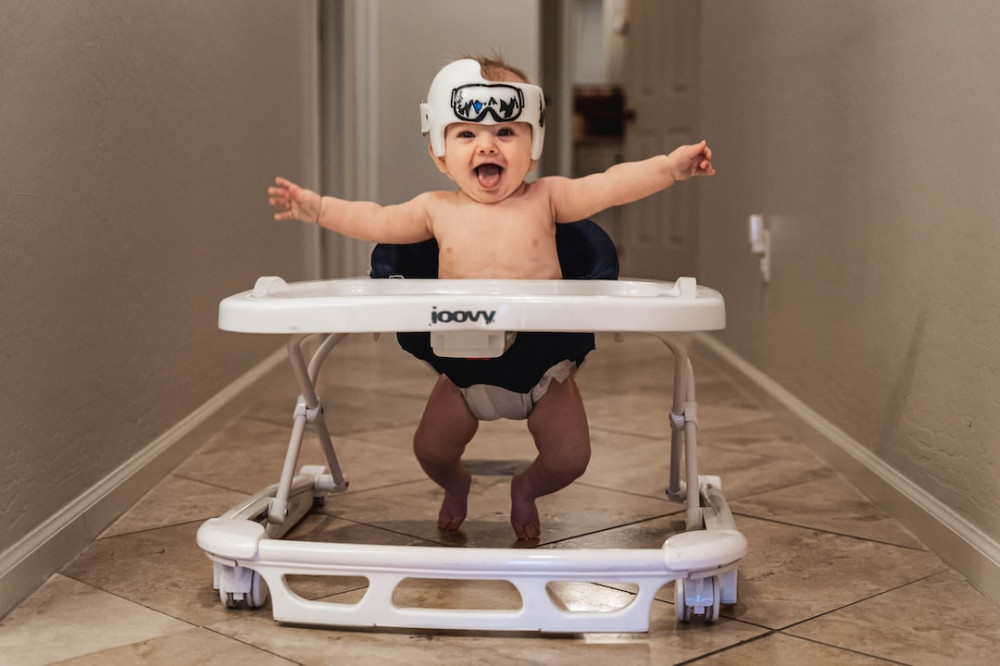
Your baby at 10 months old may be able to pull up to a standing position from sitting.
He/she may be better at crawling and is able to propel himself along the floor. Your baby could get into a
sitting position from the stomach. He/she can now stand holding on to someone or something for support.
Is now able to gain “cruise control” holding fromfurniture to furniture.
Learning
Your baby at this age likes playing with toys that move across the floor. Would
be exploring boxes, drawers and cupboards.
Childproofing cabinets and drawers is very important. Hand preference may begin to show. Enjoy games like
“clap hands”, “pat-a-cake”. Likes trying to push shapes into a shape sorter. Is interested in things which go
together. Watched people around them, and imitates what they do. If family members eat with their fingers,
shovel food in without a breath,chew loudly, reach for food instead of asking it to be passed, if everyone talks with
their mouths full, your baby will cultivate the same manners.
Rhythmic movements are now discovered. Banging of their heads, rocking and rolling seem fascinating to them
until it isnot. Provide them with toys that they can express rhythmic movements such as play drums, a spoon and
a pot that they elicit sounds.Allow your baby active play during the day.
The need to want to test out new chompers on every possible surface, parents included is a natural thing. The
biting is at first playful. After all, he’s bitten down on many teething ring, sucked on many toys, and chewed on
many crib rails. It canbecome a habit as more and more teeth come in. The baby has no idea he/she is hurting
anyone. The most effective way to respond is to remove the little biter calmly and matter-of-factly from the part
he’s biting,with a firm “No biting”. Diverthis attention with a song, toy, or other distraction. Do this every time he
bites and he will eventually understand that biting is not an acceptable behavior.
Mealtime for a ten-month-old is oftentimes not just for nourishment, but for exploring and discovering. As in
sandbox and bathtub, he’s finding out about cause and effect, textures, and temperature differences.

Language
Stops what he /she is doing and listens when he hears his name. Say one or two words consistently and
oftentimes notclearly. Dances to the rhythm of the music he hears. Chatters in the rhythm of speech but not with
meaning.
Combine different syllables. Loves to hear himself produce sounds.
As your baby learns cause and effect, explain to him what is happening. As when the opportunities present itself,
when he releases a stream in the bathtub, while you are changing his diaper, point out what is happening. Use the
term whatever you are comfortable with, pee-pee, wee-wee, urine or doodoo, BM (whatever is your family’s
traditional favorite).
As you are doing tasks, explain to your baby what you are doing, like when you are cleaning, wiping the table,
giving him bath, feeding him, cooking, etc.
Social and Emotional
Loves interactive games like peek-a-boo. Loves to hear himself laugh. Snuggles up to you when you read to him.
Loves to give cuddles and loves to receive them as well.
As his understanding of his world grows, and it is likely that he’s gotten a few “boo-boos”, he is beginning to
realize thepotentials for injury that surround him. When he was younger, he wasn’t frightened by loud noises,
though it might have momentarily startled him, because he did not perceive the possibility that it might present a
danger.
There are any number of things in a baby’s everyday life that can cause debilitating fear in him, that might be
innocuous to you, such as the barking of a dog, the whine of a siren, the roar of a vacuum cleaner, the gurgle
sound of water draining from the bathtub, being lifted high in the air (especially if he has begun to climb up, pull
up and understand depth perception, the motion of a wind-up mechanical toy.
Probably all babies experience fears at some point, though some overcome them so quickly their parents are
never aware of them. He needs to wait and confront those fears on his own terms, in his own time. when he feels
it is safe.
Take his fearsseriously, and avoid making fun of your child’s fear, calling them silly or laughing at them, as that
will only serve toundermine his ability to deal with them.
By accepting your baby’s fear as real and comforting him when he is experiencing them, you will lessen his
burden andhelp to cope. If he wails when you switch on the vacuum cleaner, be quick o pick him up, and give him
a reassuring hug. But don’t overdo the sympathy or you may reinforce the idea that there is something to be
afraid of. Though you should sympathize with his fears, your ultimate goal is to help him overcome them. He can
only do this bybecoming familiar with the things he fears, learning what they do and how they work, and gaining
some sense of controlover them. Let him touch or even play with the vacuum cleaner when it is turned off and
unplugged. He is most probablyas fascinated to the machine as he is afraid of it. When he becomes comfortable
playing with the vacuum cleaner when it isturned off, try holding hi securely in one arm while you vacuum with
the other – if it doesn’t upset him. Then show him howto turn the machine on himself, with a little help from you.
If it’s the toilet flush he fears, have him throw some paper in and encourage him to flush it down himself when he
feels ready.If it is the draining tub, let him watch the water drain when he is safely out of it, fully dressed and in
your arms.

I want you to feel that you can reach out to me if ever you have questions or want to share ideas that you have related to the care of babies, growing premature babies, and the overall health issues pertaining to the care of babies OR just drop me a comment to just say “Hello” or “what’s up”.
All The Best, Maria Teresa BabiesBuddies.com



